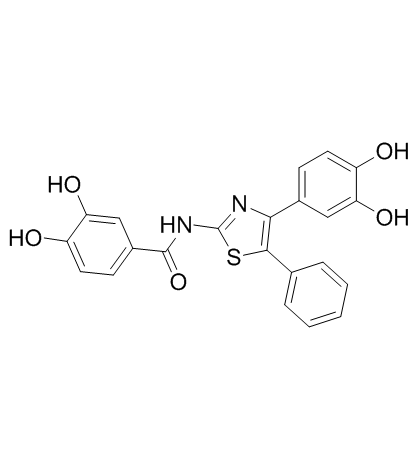| Description |
COH29 is a potent ribonucleotide reductase (RNR) inhibitor with anticancer activity. COH29 inhibits α and β subunit of RNR with IC50s of 16 μM.
|
| Related Catalog |
|
| Target |
IC50: 8 μM (RNR, KB cell), 31.57±3.35 μM (RNR, OV90 cell)[2]
|
| In Vitro |
COH29 overcome hydroxyurea and gemcitabine resistance in cancer cells. It effectively inhibits proliferation of most cell lines in the NCI 60 human cancer panel, most notably ovarian cancer and leukemia, but exerts little effect on normal fibroblasts or endothelial cells. Site-directed mutagenesis, NMR and surface plasmon resonance biosensor studies confirm COH29 binding to the proposed ligand-binding pocket and offer evidence for assembly blockade of the RRM1-RRM2 quaternary structure[1].
|
| In Vivo |
COH29 results in a dose-dependent inhibition of MOLT-4 tumor xenograft growth with twice-daily oral dosing at 50 mg/kg and 100 mg/kg, which is pronounced by Day 12 of treatment. Similarly, 7 days of treatment of mice bearing TOV11D xenografts with 200, 300, or 400 mg/kg/day COH29 results in a dose-dependent inhibition of tumor xenograft growth. Tumor growth is significantly inhibited compared with the control group[1].
|
| Cell Assay |
Cells is seeded into 96-well plates in 100 µL of complete medium at 2000 to 5000 cells per well, depending on the cell line’s growth rate. After overnight incubation, test compound is added to each well at various concentrations in 50 µL of culture medium. After a further incubation for 96 hours at 37°C, fluorescein diacetate (final concentration: 10 mg/mL) and eosin Y [final concentration: 0.1% (w/v)] is added to each well, and the cells is incubated for an additional 20 minutes at 37°C. Cytotoxicity is assessed by Digital Imaging Microscopy System detection Viability is assessed using MTS [(3-(4,5-dimethylthiazol-2-yl)-5-(3-carboxymethoxyphenyl)-2-(4-sulfophenyl)-2H-tetrazolium)] as previously described[1].
|
| Animal Admin |
Female NSG mice (NOD/SCID/IL2Rgamma null) aged 8-10 weeks are supplied. Each mouse is injected with 5×106Molt-4 or TOV-112D cells subcutaneously in the right flank, and tumor volume is monitored (0.5×l×w2). After the tumors reach approximately 70 mm3, COH29 in 30% solutol is administered daily by gavage in a one or two dose schedule. Mice is sacrificed on the 28th day after cancer cell transplantation[1].
|
| References |
[1]. Zhou B, et al. A small-molecule blocking ribonucleotide reductase holoenzyme formation inhibits cancer cell growth and overcomes drug resistance.Cancer Res. 2013 Nov 1;73(21):6484-93. [2]. Chen MC, et al. The Novel Ribonucleotide Reductase Inhibitor COH29 Inhibits DNA Repair In Vitro. Mol Pharmacol. 2015 Jun;87(6):996-1005.
|
